During such a tumultuous time at the top of politics, it is more important than ever that those of us in Parliament do all we can to ensure that the government does not take its eye off the ball when it comes to the issues that matter to the public.
Opinion
Reducing the danger from asbestos in non-domestic buildings: why the government is falling short
Something of the utmost importance to millions every day is safety in their place of work and it is the role of the cross-party House of Commons Work and Pensions Committee, which I chair, to make sure the Health and Safety Executive (HSE) is delivering when it comes to protecting workers.
HSE suddenly took on new importance as the Covid pandemic took hold and it was finally given additional funding after years of decline. It has also been given a major new role in building safety regulation following the terrible events at Grenfell Tower and the cladding scandal that followed.
In April our Committee highlighted another important issue for HSE that must not be forgotten – the continuing risk to life and health of asbestos in buildings.
 Sir Stephen Timms MP: "Asbestos-related disease is one of the great workplace tragedies of the modern era." Photograph: UK Parliament
Sir Stephen Timms MP: "Asbestos-related disease is one of the great workplace tragedies of the modern era." Photograph: UK Parliament
Despite being banned more than two decades ago, the material remains in 300,000 UK non-domestic buildings. It is the single greatest cause of work-related fatalities in the UK, with more than 5,000 deaths in 2019, including from cancers such as mesothelioma. There has been a growing number of deaths from asbestos-related diseases among retired teachers and nurses, presumably resulting from exposure during their working lives.
HSE estimates the total annual cost of deaths from mesothelioma at £3.4 billion, plus around another £3.1 billion for deaths from asbestos-related lung cancer. These figures attempt the impossible task of putting a price on the pain, grief and suffering caused to victims and their loved ones. Like many MPs, I have met distraught constituents who have lost loved ones to the horrors of mesothelioma.
It is one of the great workplace tragedies of the modern era, and a very big challenge. There have been growing calls – from trade unions, and more recently from the ‘Airtight on Asbestos’ campaign managed by the right of centre think tank Respublica – for a more effective and vigorous response.
The drive towards retrofitting to meet net zero aspirations means a lot of work will be carried out on existing buildings in the coming years – potentially increasing the risk. At the same time however such large-scale changes provide a timely opportunity to remove asbestos in a cost-effective way, alongside other work which will have to be carried out anyway. A key recommendation in our report is that this opportunity must be firmly grasped.
Remove asbestos from non-domestic buildings within 40 years
During our inquiry, the then minister for disabled people, health and work, Chloe Smith, told us that the government had a “clearly stated goal” that “it is right to – over time and in the safest way – work towards there no longer being asbestos in non-domestic buildings”.
The Committee agrees with that clearly stated goal, although we are not aware of it ever having been stated at all before, let alone clearly. We are glad it has been now.
But it isn’t good enough merely to state the goal. Our report calls for a new, system-wide strategy to remove all asbestos from public and commercial buildings. We need a clear target, as the cornerstone of a properly joined-up strategy for dealing with asbestos. We propose that ministers should set a deadline of 40 years for its removal from non-domestic buildings.
The new strategic plan should focus on removing the highest risk asbestos first, as well as early removal from the highest risk settings, including schools.
Introduce a central register of information on asbestos
As an important tool for the plan, we want to see a central register of information on asbestos.
HSE collects some data from its programme of inspections, but these cover a tiny fraction of the non-domestic premises that contain asbestos. HSE is sceptical whether a central register would give it better compliance data. We take a different view.
We think the exercise of reporting data centrally would prompt some duty holders, knowing their data is being shared centrally and may be subject to external review, to commission surveys and update records of asbestos in their premises. The resulting database would offer a sampling frame for enforcement activity and could be analysed to inform a risk-based and targeted enforcement approach. That would be valuable in itself. But it would also provide vital data to underpin a longer-term strategic approach to managing the asbestos legacy.
While the plan is being developed, there are other more immediate actions that can be taken. HSE must do much more to monitor compliance with the current asbestos regulations and boost enforcement. The number of asbestos enforcement notices issued annually by HSE dropped by 60 per cent between 2011/12 and 2018/19.
Given a drop in government funding it is not entirely surprising that enforcement work has fallen over the past decade, but the level of decline in asbestos enforcement is much greater than for
HSE enforcement work overall. There is certainly no evidence that compliance with asbestos regulations has improved dramatically during that time.
HSE should commit to a sustained increase in inspection and enforcement activity and the government should make sure that the funding is there to support it.
We also want more vigorous and effective campaigning on asbestos from HSE. Its past ‘Hidden Killer’ campaign has been widely judged a success. We have seen much less of that of late, seemingly because of a lack of resources. Our report calls for HSE to commit to investing more in sustained campaigning work.
Tighter regulation of asbestos in Europe
As part of our inquiry we looked at how asbestos removal is handled in other countries, discovering that the direction of travel in Europe is towards tighter regulation and lower exposure limits.
HSE told us that European proposals may not necessarily be grounded in the real-world experience of asbestos exposure and highlighted the problem of asbestos being so widespread in Great Britain.
An asbestos regulatory policy which prioritises only that which is immediately practical, means risking tolerating poorer health standards and higher costs in the longer-term. HSE should thoroughly assess the move towards more stringent asbestos occupational exposure limits in Europe.
The government’s response this summer, before the first change of Prime Minister, rejected our key recommendations, arguing that setting a deadline for removal would increase the risk of exposure. Such a stance fails to recognise that exposure is likely to increase in the coming years with more retrofitting of buildings as we approach net zero.
I understand that HSE is planning to be much more positive in responding to our report, in the second of the five-yearly post implementation reviews it is required to carry out of the Control of Asbestos Regulations 2012, the first having been carried out in 2017.
And I think we can also look forward to progress starting to be made outside government. I warmly welcome the initiative of the Asbestos Testing and Consultancy Association and the National Organisation of Asbestos Consultants in compiling a report for the first time in the UK to compile, analyse and understand a large body of data about asbestos in UK buildings.
The second change in Prime Minister in as many months brings with it yet another new Secretary of State for Work and Pensions, with Mel Stride replacing Chloe Smith. Fresh leadership at DWP presents an opportunity to pursue a new approach and to commit to developing a plan that deals properly with this deadly material and its continuing harmful consequences. Now is the time to grasp that chance.
Read the Committee’s report, The Health and Safety Executive’s approach to asbestos management, and the government response here
Follow Sir Stephen Timms MP:
stephentimms.org.uk
@stephenctimms
Sir Stephen Timms MP is Labour MP for East Ham and Chair of the House of Commons Work and Pensions Select Committee
OPINION

Beyond compliance: why noise control must evolve beyond PPE
By Gill Cussons, Noise & Vibration Solutions on 13 March 2025
Engineering solutions for noise control on plant, machinery and tools are often straightforward, low-cost and bring financial savings themselves, so it’s time employers moved away from the default position of purchasing and issuing personal hearing protection to workers.

Navigating a changing world
By Mike Robinson FCA, British Safety Council on 03 March 2025
Human history has hung on a timeline of change and every generation has been asked to answer the same call, to adapt and evolve. From the printing press to the PC, change has continuously re-defined both the work we do and how we do it. Where the future differs from the past is the pace at which change will impact society.

Noise-induced hearing loss: time to make it personal?
By Neal Hill, UKHCA on 28 February 2025
This year, the Health and Safety Executive (HSE) celebrated its 50th anniversary, a milestone in its long-standing mission to protect lives and improve workplace safety. 2025 is also the 20th anniversary of the Control of Noise at Work Regulations (2005). It’s also now a year since I wrote an opinion piece for Safety Management arguing that we need to harness new technology to prevent noise-induced hearing loss (NIHL).¹ So, what has happened in the meantime?



